I have been aware of the rewilding project at Knepp Castle for a while now and it is something I am very interested/curious about.
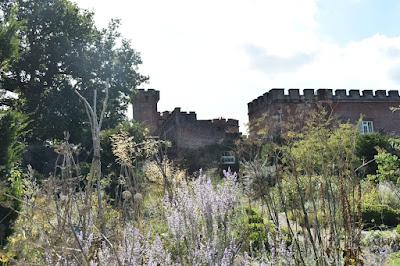
I had been bought the book 'Wilding' by Isabella Tree, who lives at Knepp with her husband Charlie Burrell and found the scale and imagination behind the project really quite awe-inspiring. They have 350 acres of land that had been traditionally farmed for generations. In 2001 they started restoring the Repton Park landscape at Knepp and from that they started to look at how much conservation they could do. In 2010 the Knepp Wildland Project received funding and from there the project has developed. There is considerable amounts of information on their website about their history and their progress.
All this means that I really wanted to visit Knepp. It is a schlep from where I live but when I saw that Gardens Illustrated where holding a Reader Day there I just had to book onto it. The day would involve talks from Charlie Harpur, Head Gardener and a tour of the recently redesigned Victorian Walled Garden led by its designer Tom Stuart Smith.
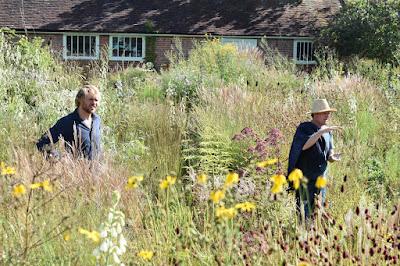
Well, what a day it was. We learned about the enormous diversity of insects, birds and wildlife that inhabit this space, including the mischievous Exmoor ponies.

The Walled Garden itself is an incredible project. There was a lot of talk about 'disturbance', how nature requires disturbance, whether that be by pigs rootling or goats grazing etc. Whilst this is mainly a principle in the outer Knepp Estate, the principles were also brought into practice in the Walled Garden where the main 'disturbance' is by humans: the gardeners who weed, who plant, who walk the paths, as we all do in our own gardens in one way or another.
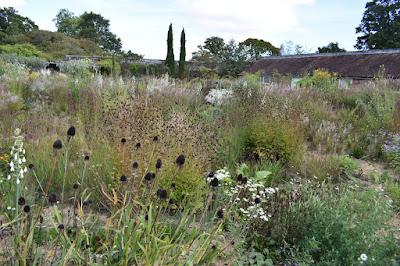
What had been until a couple of years ago a formal croquet lawn, is now this undulating space filled filled with plants that should reproduce themselves and be resilient enough to survive. The garden itself has a thick heavy clay soil, but on top of this there has been piled on tons of ground up concrete from an old dairy yard and various other rubbles. This makes the conditions really quite hard for the plants so they have to have the will to persist. It was recognised that most gardeners will not have access to an old ground up dairy yard, but not over-feeding the soil and treating things mean is something that is more doable.
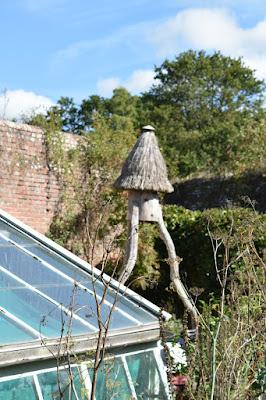
I got very intersted in the natural bee hive. A hive that is not designed for the collection of honey but for a place for bees to live. Honey bees apparently moved in very quickly and they were buzzing in and out whilst I watched. I would love to have a hive like this: it would be perfect for me as I would love to keep bees but I have no wish to be a 'bee keeper' (if that makes sense?).

The Kitchen Garden, which is part of the Walled Garden closer to the house, is run on the same principles, but without the ground gravel/rubble base. The vegetables from this garden are used for the house, much as they would have been for generations. They do grow some traditional vegetables and some that are more unusual. It looks quite jumbly and do not look too closely if you get upset about weeds and self-seeders wandering around: for me it was a delight, a successful vegetable patch that was determined not to be perfect. It is inspirational.
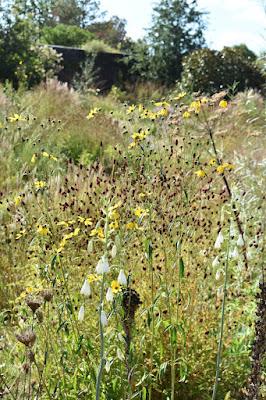
But the actual point of the day was that rewilding is not just letting weeds grow. In this garden setting there is definite control over what is growing. Yes somethings die and are left to create structures for other plants to grow up. Yes self-seeders are allowed to wander and the garden is still in the process of balancing itself as it is not much more than 18 months old. This was not a garden full of weeds, as said above the gardening team see themselves as 'agents of disturbance'; by pulling out weeds, by controllng the garden they are providing that needed agent of change. I have some things in the Press that talk about rewilding as a fad, as being about lazy gardening and being quite disparaging. It is not for everyone, but I know that my Wild Garden that I decided to allow to just 'be' when I moved into my house in 2007 is a constant delight. It has more insects in it than I could have dreamed of. I do mow it a couple of times a year, if the nettles get too much they will get reduced, but pretty much it looks after itself.
Whilst most of us do not have the amount of land that they have at Knepp, our gardens, our green spaces: even our windowboxes create vital corridors for wildlife. Gardens do not have to be 'wild' to be be habitats for all sorts of diverse wildlife so whether you want to leave a few nettles in a corner of your garden, or have a pond, or grow a small pot of pansies, it is all doing its bit.

